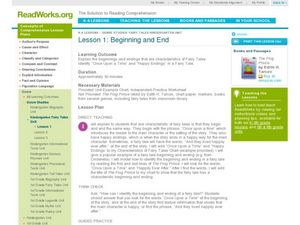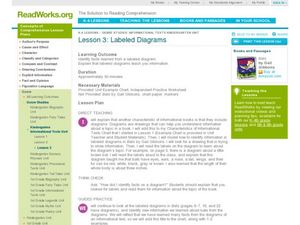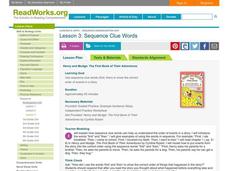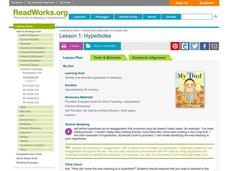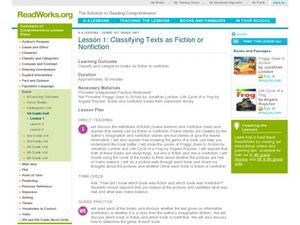Curated OER
Lesson 1: Beginning and End
Students study fairy tales. For this fairy tales lesson, students discover beginning and ending phrases characteristic of these types of stories. They listen to their teacher read The Frog Prince, take notice of those familiar phrases,...
Curated OER
Labeled Diagrams
Let's learn about bats! Those flying creatures of the night inspire a lesson about non-fiction books. They start by charting characteristics commonly found in informational texts, specifically charts, diagrams, and labels. They look at...
Curated OER
Lesson 3: Tells a Story
Kindergartners listen to a nursery rhyme and then tell the story in their own words (without rhyming). They practice as a class using Jack and Jill and then try Three Blind Mice on their own. The lesson includes a worksheet for the...
Curated OER
Step By Step Directions
Perfect for your unit on pumpkins and autumn! Learn how to write step by step directions on how to dry pumpkin seeds based on The Pumpkin Book. Youngesters also explain how they know this is a "how to" book. A fun and yummy lesson!
Curated OER
Heroes
Students read the story of Paul Bunyan and identify the characteristics and actions that make him a hero. In this heroes lesson plan, students explain their answer and draw pictures.
Curated OER
Humorous Solutions
Discover with your class the humorous solution that follows tall tales. Elementary learners will discuss the tall tale Paul Bunyan and give ordinary solutions for the problems in the story. They will read Sally Ann Thunder Ann Whirlwind...
Curated OER
Exaggeration
Students read the tall tale of Pecos Bill and identify an exaggeration in the story which they state as being part of a tall tale. In this exaggeration lesson plan, students identify the exaggeration by drawing a picture.
Curated OER
Using Pictures to Support the Main Idea
Second graders practice using photos to support the main idea. In this reading comprehension lesson, 2nd graders read and explore the photos in the book, Amazing Tigers! Students examine the photos to identify and support the main idea....
Curated OER
Using Details To Create a Title
Students read a book about leopards and create a title based on the details they read about the book. In this titles lesson plan, students read the book In the Wild: Leopards with the title covered up.
Curated OER
Identifying the Problem in a Story
Model how to identify and describe the problem in a story with Eve Bunting’s My Red Balloon. Then guide your learners through the process with Olivia and the Missing Toy. For independent practice, individuals draw a picture and write a...
Curated OER
Picture Clues and Repeated Text
Kids read The Grouchy Ladybug and predict what the outcome will be based on picture clues and repeated text. Next, they draw their predictions. A great way to use both prediction and context clue skills in your kindergarten class.
Curated OER
Pronouns and Nouns
Second graders identify nouns and pronouns from a story. In this nouns and pronouns lesson, 2nd graders review the definition of these words. Students then locate nouns and pronouns in the book they are reading. Students list these words...
Curated OER
Sequence Clue Words
Young learners use sequence words to describe pictures they draw of events happening in a story. To practice sequencing events, they use words such as first, then, next, and more.
Curated OER
Lesson 1: Effects
If You Give a Mouse a Cookie is a perfect book to use when your class is ready to learn about cause and effect. They consider the meanings of the words cause and effect as you read the story. Working together you'll identify, discuss,...
Curated OER
Causes
Things usually don't happen without a reason; usually any event has a cause that got the ball rolling. The book, If You Give a Mouse a Muffin is used to help learners understand the concept of causes in literature. Examples from the...
Curated OER
Lesson 3: Cause and Effect Relationships
The Gunniwolf is a book full of events that get kids asking why and what. They note several events on a chart, and then discuss how they think the instructor is able to determine the causes and effects they find. They continue reading...
Curated OER
Lesson 3: Looks, Actions, and Feelings
Remember that boy David from the David, No! books? He's back, and youngsters draw a picture of him from a scene in the book David Goes to School. They write a sentence describing his appearance, actions, and feelings as they discuss how...
Curated OER
Lesson 1: Identifying Information in Nonfiction
If you are in need of a lesson on identifying information in a non-fiction text, look no further. The class learns how to use a KWL chart to identify explicit information in the book, Frogs by Gail Gibbons. They fill out the KWL chart,...
Curated OER
Hyperboles
Want to see the best lesson is the entire universe? Who doesn't love to exaggerate now and then? Get your class cozy with hyperbole as you read the story My Dad by Anthony Browne. During the reading you'll chart and analyze the...
Curated OER
Lesson 1: Classifying Texts as Fiction or Nonfiction
First graders characterize fiction and non-fiction books, they discover the characteristics of each type of book and compare two books (one fiction & one nonfiction) about the same subject. They make a list that describes what makes...
Curated OER
Lesson 2: Chronological Order
Examining life events is a great way to learn about chronological order. Sequencing and time order are analyzed after reading a book about Rosa Parks. With a chart, the class works together to put the events from Mrs. Parks' life in the...
Curated OER
Significant Contribution
Examine the lives of people who have made a significant contribution to society. The concept of biography is discussed with the class; they identify important actions, and read passages about Sacagawea and Benjamin Franklin. They write...
Curated OER
Lesson 1: Plot Problems
Add another characteristic to your class characteristics of fairy tales chart. First they discuss the concept of problems or conflicts found in most fairy tale plots then they practice identifying conflict as they read. They read the...
Curated OER
The Rule of Three
What makes a fairy tale a fairy tale? Teach young readers one characteristic that defines the fairy tale genre. They'll learn that events, objects and characters in fairy tales often occur in threes. They read Goldilocks and the Three...


